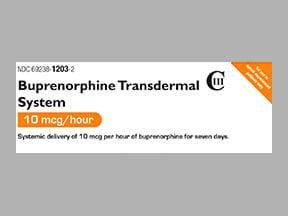
Butrans Coupons & Savings Card – Discount Prices from $65.30
Brand for: Buprenorphine
My prescription
Edit
10MCG/HR, Buprenorphine (4 Patch Weeklies)
Select pharmacy

CVS
$65.30
COUPON PRICE
Walgreens
$135.60
COUPON PRICE
Albertsons
$143.97
COUPON PRICE
Walmart
$258.91
COUPON PRICEButrans savings card
Show this card to your pharmacist
CVS
$65.30
BIN
ID
PCN
GRP
019876
LH32DBEC84
CHIPPO
LHX
Powered by
Related opioid agonist/antagonists prescriptions
More prescriptions for pain
Related opioid agonist/antagonists prescriptions
More prescriptions for pain
Price history for Butrans (brand) & Buprenorphine (generic)
4 Patch Weeklies, 10MCG/HR
Average retail price for Butrans
Average retail price for Buprenorphine
Average SaveHealth price for Buprenorphine
Our price history data is based on aggregated prescription data collected from participating pharmacies in America. Our prescription data updates daily to reflect the latest price changes. If you notice a missing data point, it means there wasn't sufficient data available to generate a monetary value for that date.
Over the last 12 months, the average discount price of Butrans is $40.75 using the SaveHealth savings card. That's an average savings of 67.39% on Butrans with our discount card.
*Retail prices are based on pharmacy claims data, and may not be accurate when we don't have enough claims.
Butrans (Buprenorphine) dosage forms
Dosage Quantity Price from Per unit 5MCG/HR 1 Patch Weekly $26.18 $26.18 5MCG/HR 2 Patch Weeklies $34.36 $17.18 5MCG/HR 3 Patch Weeklies $42.53 $14.18 5MCG/HR 4 Patch Weeklies $50.71 $12.68 5MCG/HR 7 Patch Weeklies $75.25 $10.75 7.5MCG/HR 1 Patch Weekly $29.55 $29.55 7.5MCG/HR 2 Patch Weeklies $41.10 $20.55 7.5MCG/HR 3 Patch Weeklies $52.65 $17.55 7.5MCG/HR 7 Patch Weeklies $98.85 $14.12 10MCG/HR 1 Patch Weekly $29.83 $29.83
| Dosage | Quantity | Price from | Per unit |
|---|---|---|---|
| 5MCG/HR | 1 Patch Weekly | $26.18 | $26.18 |
| 5MCG/HR | 2 Patch Weeklies | $34.36 | $17.18 |
| 5MCG/HR | 3 Patch Weeklies | $42.53 | $14.18 |
| 5MCG/HR | 4 Patch Weeklies | $50.71 | $12.68 |
| 5MCG/HR | 7 Patch Weeklies | $75.25 | $10.75 |
| 7.5MCG/HR | 1 Patch Weekly | $29.55 | $29.55 |
| 7.5MCG/HR | 2 Patch Weeklies | $41.10 | $20.55 |
| 7.5MCG/HR | 3 Patch Weeklies | $52.65 | $17.55 |
| 7.5MCG/HR | 7 Patch Weeklies | $98.85 | $14.12 |
| 10MCG/HR | 1 Patch Weekly | $29.83 | $29.83 |
| 10MCG/HR | 2 Patch Weeklies | $41.65 | $20.82 |
| 10MCG/HR | 3 Patch Weeklies | $53.48 | $17.83 |
| 10MCG/HR | 4 Patch Weeklies | $65.30 | $16.32 |
| 10MCG/HR | 7 Patch Weeklies | $100.78 | $14.40 |
| 15MCG/HR | 1 Patch Weekly | $32.46 | $32.46 |
| 15MCG/HR | 2 Patch Weeklies | $46.91 | $23.45 |
| 15MCG/HR | 3 Patch Weeklies | $61.37 | $20.46 |
| 15MCG/HR | 4 Patch Weeklies | $75.83 | $18.96 |
| 20MCG/HR | 1 Patch Weekly | $36.73 | $36.73 |
| 20MCG/HR | 2 Patch Weeklies | $55.46 | $27.73 |
| 20MCG/HR | 3 Patch Weeklies | $74.19 | $24.73 |
| 20MCG/HR | 4 Patch Weeklies | $92.92 | $23.23 |
| 20MCG/HR | 6 Patch Weeklies | $130.37 | $21.73 |
Butrans Warnings
Buprenorphine patches (Butrans) require careful consideration due to potential risks and safety concerns. It is crucial to follow medical guidance precisely and be aware of the following safety information:
Risk of Addiction and Misuse: Buprenorphine is a Schedule III controlled substance with a risk of addiction and misuse, which can lead to overdose or death. Avoid placing the patch in the mouth, chewing, or swallowing it. Discuss with your healthcare provider about having naloxone on hand to counteract possible opioid overdoses.
Severe Respiratory Depression: This medication can cause dangerously slow breathing, especially when starting treatment or increasing the dose. This risk is heightened by alcohol, other sedatives, or existing respiratory conditions. Seek emergency care if symptoms like slow/shallow breathing, extreme sleepiness, or difficulty waking occur.
Overdose Precautions: Use the medication exactly as prescribed to prevent overdose. Store it securely away from children, pets, and unauthorized users. Signs of overdose include extreme drowsiness, slow heartbeat, and cold, clammy skin. Keep naloxone accessible and educate family members on its use.
Cognitive and Motor Impairment: Buprenorphine can cause drowsiness and impair thinking and reaction times. Avoid alcohol and other sedative medications. Assess how the medication affects you before engaging in tasks that require alertness, such as driving.
Pregnancy and Newborn Risks: Using buprenorphine during pregnancy may lead to dependency in the unborn child, causing withdrawal symptoms after birth. Use the lowest effective dose for the shortest duration and inform healthcare providers if you are pregnant or plan to become pregnant.
Temperature Sensitivity: Exposure to heat (e.g., from fever, exercise, or external sources like heating pads) can increase drug release from the patch, leading to adverse effects. Avoid exposing the patch to high temperatures.
Adrenal Insufficiency: Prolonged use may result in low adrenal hormone levels. Report symptoms like fatigue, nausea, or loss of appetite to your healthcare provider.
Blood Pressure and Liver Concerns: Buprenorphine can cause low blood pressure and liver damage. Regular monitoring and communication with your healthcare provider are important, especially if you have a history of liver problems or take medications that affect blood pressure.
Withdrawal Symptoms: Sudden discontinuation can lead to withdrawal symptoms. Consult your healthcare provider to taper the dose safely.
Seizure Risk: If you have a history of seizures, be cautious as buprenorphine may increase seizure frequency.
Heart Rhythm Issues: Buprenorphine can cause QT prolongation, affecting heart rhythm. Discuss your complete medical history with your healthcare provider to assess this risk.
This medication is contraindicated in individuals with severe respiratory depression, asthma, gastrointestinal blockages, or previous allergic reactions to buprenorphine. Always consult with your healthcare provider for personalized advice and adhere strictly to the prescribed regimen to minimize risks.
Butrans Side Effects
When using this medication, some individuals may experience common side effects that are generally mild and manageable. These include nausea, itching or redness at the application site, dizziness, headache, drowsiness, constipation, vomiting, dry mouth, and upset stomach. It's important to note that these side effects often improve as your body adjusts to the medication. Staying hydrated, consuming fiber, and regular exercise can help prevent constipation. To minimize dizziness, rise slowly from sitting or lying positions. In some cases, other side effects such as tiredness, increased sweating, and swelling in the arms, legs, or ankles may occur. If these or any symptoms persist or worsen, it is advisable to consult your healthcare provider for guidance. More serious side effects, though rare, require immediate medical attention. These include dangerously slow breathing, signs of an overdose such as extreme sleepiness and slow heartbeat, and symptoms of opioid withdrawal like anxiety or severe skin reactions. Additionally, any signs of heart rhythm problems or serious allergic reactions, such as rash, hives, or difficulty breathing, warrant urgent care. A rare but serious risk includes liver damage, indicated by persistent nausea or vomiting, dark urine, loss of appetite, yellowing of the skin or eyes, and severe abdominal pain. If you experience any of these serious side effects, seek medical help right away. Always report any unexpected side effects to your healthcare provider.
Butrans Interactions
What is the drug Butrans used for?
Butrans is used for managing severe pain that requires continuous, long-term opioid treatment and for which alternative treatment options are inadequate. It is a transdermal patch that delivers buprenorphine, an opioid analgesic, through the skin.
Is Butrans 5 equivalent to morphine?
Butrans 5 is not equivalent to morphine. Butrans contains buprenorphine, which is a partial opioid agonist, while morphine is a full opioid agonist. They are different medications with different potencies and mechanisms of action. The equivalence between these two medications would depend on specific dosing and individual patient factors, and should be determined by a healthcare professional.
Is Butrans the same as suboxone?
Butrans and Suboxone are not the same. Butrans is a transdermal patch that contains buprenorphine, used for managing chronic pain. Suboxone, on the other hand, is a combination of buprenorphine and naloxone, used primarily for the treatment of opioid dependence. While both contain buprenorphine, their formulations and primary uses differ.
Why do doctors prescribe buprenorphine for pain?
Doctors may prescribe buprenorphine for pain because it is an opioid medication that can effectively manage moderate to severe pain. It works by binding to opioid receptors in the brain, altering the perception of pain. Additionally, buprenorphine has a ceiling effect, which means it has a lower risk of causing respiratory depression compared to other opioids, making it a safer option for some patients. It is also used in certain cases for its long-acting properties and lower potential for misuse.
What is the difference between Suboxone and Butrans?
Suboxone and Butrans both contain buprenorphine, but they are used for different purposes. Suboxone is a combination of buprenorphine and naloxone, and it is primarily used for the treatment of opioid dependence. The naloxone component is included to deter misuse. Butrans, on the other hand, is a transdermal patch that contains only buprenorphine and is used for managing chronic pain. The delivery method and the presence of naloxone in Suboxone are the main differences between the two.
